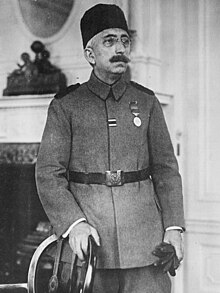| Mehmed VI | |||||
|---|---|---|---|---|---|
| Custodian of the Two Holy Mosques Khan | |||||
 Mehmed VI in 1918 | |||||
| Sultan of the Ottoman Empire (Padishah) | |||||
| Reign | 4 July 1918 – 1 November 1922 | ||||
| Predecessor | Mehmed V | ||||
| Successor | Monarchy abolished | ||||
| Grand Viziers | |||||
| Ottoman caliph (Amir al-Mu'minin) | |||||
| Reign | 4 July 1918 – 19 November 1922 | ||||
| Predecessor | Mehmed V | ||||
| Successor | Abdulmejid II | ||||
| Head of the Osmanoğlu family | |||||
| Reign | 19 November 1922 – 16 May 1926 | ||||
| Successor | Abdulmejid II | ||||
| Born | 14 January 1861 Dolmabahçe Palace, Constantinople, Ottoman Empire | ||||
| Died | 16 May 1926 (aged 65) Sanremo, Liguria, Italy | ||||
| Burial | 3 July 1926[1] Cemetery of Sulaymaniyya Takiyya, Damascus, Syria | ||||
| Consorts | |||||
| Issue |
| ||||
| |||||
| Dynasty | Ottoman | ||||
| Father | Abdulmejid I | ||||
| Mother | Gülistu Kadın (biological) Şayeste Hanım (adoptive) | ||||
| Religion | Sunni Islam | ||||
| Tughra |  | ||||
Mehmed VI Vahideddin (Ottoman Turkish: محمد سادس Meḥmed-i sâdis or وحيد الدين Vaḥîdü'd-Dîn; Turkish: VI. Mehmed or Vahdeddin/Vahideddin; 14 January 1861 – 16 May 1926), also known as Şahbaba (lit. 'Emperor-father') among the Osmanoğlu family,[3] was the last sultan of the Ottoman Empire and the penultimate Ottoman caliph, reigning from 4 July 1918 until 1 November 1922, when the Ottoman sultanate was abolished and replaced by the Republic of Turkey on 29 October 1923.
The brother of Mehmed V Reşâd, he became heir to the throne in 1916, after the death of Şehzade Yusuf Izzeddin, as the eldest male member of the House of Osman. He acceded to the throne after the death of Mehmed V.[4] He was girded with the Sword of Osman on 4 July 1918 as the 36th padishah and 115th Islamic Caliph.
Mehmed VI's reign began with the Ottoman Empire suffering defeat by the Allied Powers with the conclusion of World War I. The subsequent Armistice of Mudros legitimized further Allied incursions into Ottoman territory, resulting in an informal occupation of Istanbul and other parts of the empire. An initial process of reconciliation between the government and Christian minorities over their massacres and deportations by the government ultimately proved fruitless, when the Greeks and Armenians, via their patriarchates, renounced their status as Ottoman subjects by the end of 1918, spelling a definitive end of Ottomanism. During the Paris Peace Conference, Mehmed VI turned to Damat Ferid Pasha to diplomatically outflank Greek territorial demands on the Ottoman Empire through Allied appeasement, but to no avail. Unionist elements within the Ottoman military, discontent with the government's appeasement in the face of partition, and the establishment of war crimes tribunals, began taking actions into their own hands by establishing a nationalist resistance. Mehmed's most significant act as Sultan was dispatching Mustafa Kemal Pasha (Atatürk) to reassert government control in Anatolia, which actually resulted in the further consolidation of anti-appeasement actors against the court, and consequently, the end of the monarchy.
With the Greek Occupation of Smyrna on 15 May 1919 galvanizing the Turkish nationalist movement and beginning the Turkish War of Independence, by October the sultan's government had to give in to nationalist demands with the Amasya Protocol. With the Turkish nationalists standing against Allied designs for a partition of Ottoman Anatolia, the Allies militarily occupied Istanbul on 16 March 1920, and pressured Sultan Mehmed VI to dissolve the Nationalist dominated Chamber of Deputies, ending the Second Constitutional Era. Kemal Pasha responded by establishing a provisional government known as the Grand National Assembly based in Ankara, which dominated the rest of the Ottoman Empire, while the Sultan's unpopular government in Istanbul was propped up by the Allied powers and effectively impotent. His ministers would go on to sign the Treaty of Sèvres, a peace treaty which would have partitioned the remainder of his empire leaving a rump Turkish state. With Ankara's victory in the independence war, the Sèvres Treaty was abandoned for their Treaty of Lausanne. On 1 November 1922, the Grand National Assembly voted to abolish the Sultanate and to depose Mehmed VI as Caliph, and he left for Europe in exile. On 29 October 1923, the Republic of Turkey was declared, with Mustafa Kemal as its first president.
- ^ Cite error: The named reference
Mehmedwas invoked but never defined (see the help page). - ^ Ali Aktan (1995). Osmanlı paleografyası ve siyasî yazışmaları. Osmanlılar İlim ve İrfan Vakfı. p. 90.
- ^ Murat Bardakçı (2017). Neslishah: The Last Ottoman Princess. p. 85.
- ^ Freely, John, Inside the Seraglio, 1999, Chapter 16: The Year of Three Sultans.